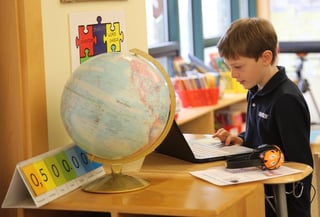Watching children learn an additional language is a lot like seeing them swim for the first time. Some children dive right in and are soon paddling around the deep end. Others take their time, dipping a toe in the water and gradually venturing out from the shore.
It’s common to believe that a child’s skill with learning an additional language comes naturally. We don’t agree. Yes, some children do pick up language skills faster than others—but that doesn’t mean that the ability to learn a language is an attribute possessed by only a lucky few. When students start learning an additional language at Whitby, some do soak up the knowledge faster than others. Yet it’s not just natural ability at work. We've actually found that there are many internal and external factors that influence how fast students pick up a new language.
When students start learning an additional language at Whitby, some do soak up the knowledge faster than others. Yet it’s not just natural ability at work. We've actually found that there are many internal and external factors that influence how fast students pick up a new language.
9 Factors that Influence Language Learning for Kids
1. Motivation
Is the child being forced to learn, or do they want to learn the language?
When a child understands the importance of understanding a language and can see how it directly applies to their life, they learn faster. We’ve found that a contextual, theme-based curriculum can help get students more excited to dive into language learning. When they are interested in learning a language and they see meaningful connections to their lives, they begin to take risks to produce language, which helps them to acquire it faster.
2. Support at Home
Is another language spoken at the child’s home? What’s their exposure level to different languages?
We’ve found that exposure is an important factor in language comprehension and acquisition. If a child’s family only speaks one language, are they able to provide help when the student needs it? It also matters how much value parents place in learning an additional language. Parents who prioritize language learning are more likely to push their child to keep trying even when it feels difficult.
3. Prior Linguistic Knowledge
Is the language they’re learning their first foreign language?
Once a child has studied and acquired a language, their skill at learning another will increase. Language learners have the ability to translate skills from one language to another because they’re able to recognize the rules and patterns of language, even if the vocabulary is different.
4. Learning Environment
How does the child feel in the classroom?
Another key factor is how comfortable students feel in their language learning environment. Does their classroom feel cold and tense, or positive and relaxing? What’s the school’s culture and beliefs about language learning? We’ve found that a student’s learning environment has an impact on their motivation—a low anxiety language learning environment increases the chance for acquisition.
5. Teaching Strategies
How is the language taught?
The strategies a language teacher uses have a big impact on language learning. How does the teacher help students understand the concepts of a language? How does the teacher take different learning styles into account, as well as different levels of comprehension? For example, watching a film in the target language and writing and performing skits in the target language reach multiple learning styles. Offering an immersion experience helps students connect the language learning to their everyday lives, but rote vocabulary memorization and grammar drills create 'meaning-less' language lessons.
6. Comprehensible Input
How attainable does the language feel to the student?
Linguist Stephen Krashen is known for developing the input hypothesis of second-language acquisition. In this context, the titular “input” is the language curriculum. Krashen wrote that teaching at just any level of difficulty isn’t sufficient: the input received by a student must be comprehensible. In other words, the curriculum must reach a child at their current level and challenge them with activities and just 1 level beyond their current stage. If the material feels out of reach, the student can feel “shut down” and have trouble engaging with the lesson. To make sure that students feel motivated to learn, it’s important to ensure that they feel like they have the ability to progress to the next level of learning.
7. Student Personality
Is the student introverted or extroverted?
A student’s personality can affect how they learn a second language. More introverted students have been shown to take longer to acquire a language because they’re more hesitant to make mistakes. Extroverted students, on the other hand, are more likely to go out on a limb and try out their newly learned vocabulary. To ensure that both personality types succeed, it’s important to create an environment where students understand that mistakes are part of the learning process and it’s more important to speak than to be perfect.
8. Age
How old is a student when they start learning a foreign language?
While students of all ages can learn a foreign language, there is consensus that certain aspects are affected by the age of the learner. It becomes harder for students to have native pronunciation from the teen years. Some students also find that it’s more difficult to fully acquire a foreign language as they get older, but this isn’t true of everyone.
9. Comfort in their Country of Residence
How happy are students in the country where they are studying a language?
A final factor in language learning is the child’s comfort in the current country of residence. Most children move to a new country because of a parent's job, not by choice. As a result, their motivation to learn a new language can depend on whether they’re happy to be in a new place, or if they’ve come kicking and screaming. Luckily, even if a child is unhappy at first, their attitude can shift if they feel welcomed by their teachers and supported by their parents.
Language Learning at Whitby
Language learning is not a skill that children either have or don’t. There actually are many internal and external factors that influence how fast children pick up a new language—from the child’s personality to the way language is taught at their school.
To learn more about the unique learning environment at Whitby, schedule a tour or download our guide to the difference between an N8 and K12 education.



